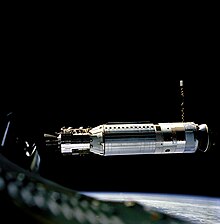
Back آر إم-81 أغينا Arabic Аджена Bulgarian Agena Catalan Agena (raketový stupeň) Czech Agena German Agena Spanish Agena (étage de fusée) French Agena (foguete) Galician RM–81 Agena Hungarian RM-81 Agena ID
 Agena-D outfitted as a Gemini program Target Vehicle | |
| Manufacturer | Lockheed Corporation |
|---|---|
| Country of origin | United States |
| Used on | |
| General characteristics | |
| Height | 248 inches (6.3 m) |
| Diameter | 60 inches (1.5 m) |
| Launch history | |
| Status | retired |
| Total launches | 365 |
| First flight | 1959 |
| Last flight | February 12, 1987 |
| RM-81 Agena | |
| Powered by | One Bell XLR-81 |
| Maximum thrust | 16,000 pounds-force (71 kN) |
| Specific impulse | 293 seconds (2.87 km/s) (vac) |
| Burn time | 120–265 s |
| Propellant | UDMH/Red fuming nitric acid |
The RM-81 Agena (/ədʒinə/) was an American rocket upper stage and satellite bus which was developed by Lockheed Corporation initially for the canceled WS-117L reconnaissance satellite program.[1] Following the division of WS-117L into SAMOS and Corona for image intelligence, and MIDAS for early warning, the Agena was later used as an upper stage, and an integrated component, for several programs, including Corona reconnaissance satellites and the Agena Target Vehicle used to demonstrate rendezvous and docking during Project Gemini. It was used as an upper stage on the Atlas, Thor, Thorad and Titan IIIB rockets, and considered for others including the Space Shuttle[2] and Atlas V. A total of 365 Agena rockets were launched between February 28, 1959[3] and February 1987. Only 33 Agenas carried NASA payloads and the vast majority were for DoD programs.
On some missions, the payload was built directly into the Agena, which provided it with electric power, communications and three-axis stabilization. Payload components were usually located ahead of the Agena's standard bulkhead. On missions where the payload was not built into the Agena, and instead separated after launch, the Agena was known as an Ascent Agena. The Agena was upgraded twice from the original Agena A in order to support heavier and more sophisticated satellites, such as Corona spacecraft with multiple and more powerful cameras.
The Agena name was suggested by the Department of Defense's Advanced Research Projects Agency for the star Beta Centauri, also known as Agena, because this upper stage would "ignite in the sky". This followed Lockheed's tradition of naming products for stellar phenomena.[4]
The final launch was of an Agena D on February 12, 1987, configured as the upper stage of a Titan 34B. In all, 365 Agena vehicles were launched by NASA and the US Air Force.[5]
- ^ Jacob Neufeld; George M. Watson, Jr. & David Chenoweth (1997). "Technology and the Air Force A Retrospective Assessment" (PDF). Air Force History and Museums Program. Archived from the original (PDF) on October 7, 2012.
- ^ Cite error: The named reference
ShuttleAgenaExwas invoked but never defined (see the help page). - ^ Cite error: The named reference
AGENA_Flight_Historywas invoked but never defined (see the help page). - ^ Helen T. Wells; Susan H. Whiteley & Carrie E. Karegeannes. Origin of NASA Names. NASA Science and Technical Information Office. pp. 6–7.
- ^ "Lockheed RM-81 Agena". www.designation-systems.net.